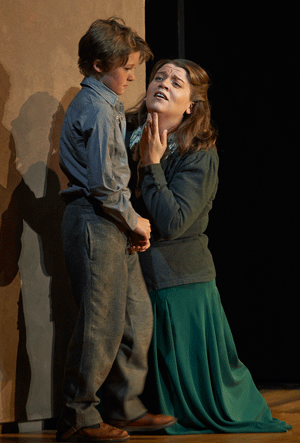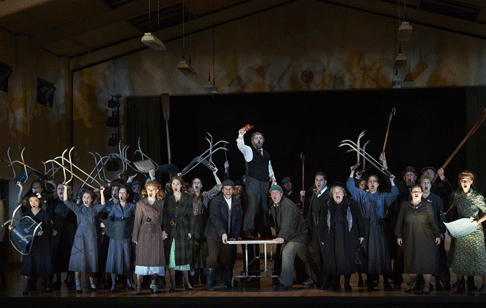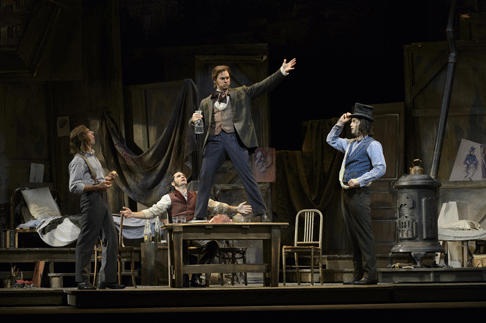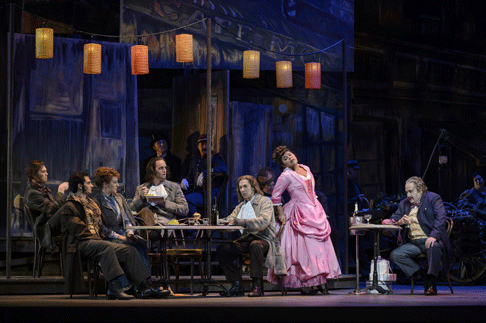From the moment Tom Corbeil opened his mouth as Swallow at the start of Peter Grimes, I knew we were in for a special night. For Mr. Corbeil not only boasts a smoky-hued bass-baritone of real distinction but he sings with real dramatic insight. Where other Swallow’s have been content to be large-and-in-charge, barking for volume as they accuse the title character, this young singer found more strength in understatement, more power in variety. That is not to say he cannot sing with commanding strength and security, just that he wisely chose to be selective. From this auspicious beginning, the performances just went from strength to strength.
Alan Held’s Balstrode is a towering achievement. I might have said “colossal” but I may have said that the last time I encountered this consistently fine artist. Mr. Held once again unleashed his enormous, pointed sound to etch a finely shaded performance. As Ellen, Ileana Montalbetti’s creamy soprano sounded lush and even in melismatic passages, and she found real spinto heft for the more contentious exchanges. Her Embroidery Aria may be the finest I have yet heard, her limpid phrasings underpinned with melancholy.
 Jakob Janutka as John, Peter Grimes’s apprentice, and Ileana Montalbetti as Ellen Orford
Jakob Janutka as John, Peter Grimes’s apprentice, and Ileana Montalbetti as Ellen Orford
Jill Grove was a forceful, no-holds-barred Auntie with a full-bodied chest voice wedded to a lower- and upper-middle that rang out in the house. In addition to a superior technique, Ms. Grove also sported the best diction I have ever heard from anyone in this part. Ileana and Jill were also stellar in one of the evening’s highlights, as their voices effortlessly intertwined in the famous quartet, complemented by COC Ensemble Studio’s Claire de SÈvignÈ and Danielle MacMillan as Nieces 1 and 2, respectively. These two fine sopranos are proof positive that that young artist development program is such a fine investment.
Veteran Judith Christin does not miss a trick as the meddling Mrs. Sedley. Like Fedora Barbieri before her, she overcame time’s diminishment of her lower register by pouring on the steam in the chest and upper register and using her years of experienced stage moxie to wend through the rest without losing meaning or continuity. Roger Honeywell was luxury casting as Bob Boles. Mr. Honeywell sang the title role himself to great acclaim this summer in Des Moines. As Boles, his steely tenor has never sounded better. Indeed his tone was more elastic, pliable, and easily produced than in previous encounters. This was surely the finest Boles you can imagine hearing.
Peter Barrett was a handsome Ned Keene, and his strapping appearance was married to a virile, gleaming baritone that easily captured the many facets of Ned’s carousing personality. Ensemble Studio’s Owen McCausland created a memorable Reverend Adams with his pure tenor and clean projection (attributes that also benefited his Parpignol the next night). Little Jakob Janutka was haunting as the abused apprentice John.
At the show’s heart, Ben Heppner’s Grimes proved to be more earth-bound than some interpreters. His tortured, hulking, hangdog fisherman was not so much a demented loose cannon as a calculated brute. His final great rant was almost more a lament than a mad scene. On his highly individualized terms, Mr. Heppner’s interpretation worked handsomely, with his character’s arc consistent and moving. He decisively surmounted all of the vocal challenges of the part. Ben’s weighty lyric voice is now marked by an occasional huskiness, and beauty of tone was occasionally sacrificed in order to nail a high note. But in this role, at his age, a few rough edges are more ‘patina’ than ‘problematic.’ Ben Heppner remains one of the finest Grimes in the world today.
 A scene from Peter Grimes
A scene from Peter Grimes
Director Neil Armfield has concocted a fascinating concept with outstanding assistance from his production team: Ralph Myers (Set Design), Tess Schofield (Costume Design), and Damien Cooper (Lighting Design, recreated by Wendy Greenwood). Together they place the story in the Aldeburgh town hall (read: multi-purpose room) just at the end of World War II. Mr. Myers’ drab, box-set interior was characterized by institutional colors, folding tables and stacking chairs, (retractable) fluorescent ceiling lighting fixtures, and community stage with velvet pull-curtain. While it seemed it would work well for the opening courtroom scene, I worried it might wear out its welcome as a playing environment as the evening progressed. It is high praise indeed to say it did not.
This is owing to the very clever addition.of carefully selected set pieces, the placement of which was directed by an added character, one “Dr. Crabbe” whose works inspired the opera. Actor Thomas Hauff was at times stage manager, at times supernumerary, and at times provacateur. This framing device was very effective in imparting a somewhat unrehearsed feeling to the telling of the tale. It should also not be under-estimated how important Ms. Schofield’s character-specific costumes were in providing clarity and purpose to the proceedings. In a show with so many individualized minor roles, it is extremely important to be able to visually identify them and recall how they all fit into the puzzle.
Mr. Cooper’s lighting was also a powerful partner in creating time of day, defining interior or exterior, and heightening psychological dispositions. He used some great disorienting effects that perfectly accented key moments. Best of all, Denni Sayers has (re-)directed this revival with a sure hand, distilling the complex relationships with clarity, and creating staggering stage pictures with citizens of the Borough, with the COC Chorus offering their most stunning performance to date under Chorus Master Sandra Horst.
Only one moment misfires, when Dr. Crabbe is left alone to slowly stack and clear all of the chairs to the left and right apron, in order for the upstage wall to track far forward to reveal Peter’s hut on the stage-within-a-stage. While I appreciate the chairs had to get out of the way to facilitate this effect, I am afraid there is not one bar of “chair-stacking” music in the ensuing Sea Interlude that thence got relegated to underscoring..
 (Left to Right) Phillip Addis as Marcello, Eric Margiore as Rodolfo, Cameron McPhail as Schaunard and Tom Corbeil as Colline [Photo by Chris Hutcheson]
(Left to Right) Phillip Addis as Marcello, Eric Margiore as Rodolfo, Cameron McPhail as Schaunard and Tom Corbeil as Colline [Photo by Chris Hutcheson]
But what a score this is! And what a splendid, virtuoso performance Music Director Johannes Debus drew from his.fine orchestra. Whether in ensemble or solo passages, the instrumentalists proved they are among the top tier of pit orchestras with a reading that was thrilling in its detail and passion. Maestro Debus continues to prove he can wring consummate music-making from his assembled forces while also imbuing the effect with a jolting theatrical charge.
John Caird’s direction of La bohËme was constantly inventive yet truthfully presented. Mr. Caird managed to develop wonderfully complex characters with his superb cast, yielding performances rich with subtext and personal history. I will not soon forget the entrance he devised for Mimi, having her faint to the floor at the first musical opportunity, reducing the stymied Rodolfo to dipping his fingers into a jug and lamely flicking water on the girl’s face in an attempt to revive her. The director was full of happy surprises all evening long.
The sprawling CafÈ Momus scene was rife with detail all the while the stage traffic was exceedingly well-managed. The excellent children’s chorus was especially well used and the bustle eventually settled down to place the principals stage right where the action was particularly well-focused. Having Musetta sit almost back to back with Marcello allowed her to naughtily tease him with some rather steamy pawing and groping during Quando m’en vo. On the three instrumental stings just before she begins that aria, she snapped her nail on her wine glass to get everyone’s attention, prompting appreciative chuckles from the audience that such overly familiar material could seem new again.
Much of what Mr. Caird was able to achieve must have been owing to a fertile collaborative process with David Farley who devised an ingenious set design. The look of this production was based on the concept of using collages of Marcello’s paintings to create walls, roofs, doors. . .well pretty much everything. With a nod to Toulouse Lautrec the act curtain is one great canvas that prominently features two women, presumably Mimi and Musetta, as muses (or distractions).
Marcello is often painting, usually discovered in action behind the scrim at the start of scenes, stopping to make a sketch now and again, even documenting Mimi’s death. Rodolfo, too, is compelled to write, subtly pulling out a small diary periodically to record some observation or emotion for future use. The constant ‘creative’ impulse of the four bohemians made for relationships of unusual depth. This is not to say that the buoyant horseplay and camaraderie were in any way muted. The dancing and fencing in Act Four was delightfully impulsive and seemed breathlessly impromptu, perfectly setting up the sure-fire moment when Musetta bursts through the door.
 A scene from La BohËme [Photo by Chris Hutcheson]
A scene from La BohËme [Photo by Chris Hutcheson]
It is a testament to the stagecraft that Ce’Ë MimÌ… was so intense that it chilled even those of us who knew what came next. Nor was the famous ending any less well-served. With beautiful stage pictures unfolding and an inevitability about the interplay and movement, the team crafted an unforgettable final impression, Rodolfo, his back almost to us, pulling the deceased Mimi into his arms, clasping her tight and keening, rocking her back and forth, back and forth. . .well it doesn’t get any better than this.
None of this stagecraft would have mattered, had not the cast been up to the task. It almost seemed as though the arrival of a new era of thrilling bohemian proponents had been announced with this performance. I might have to hearken back to Ricciarelli and Carreras at the Met, or perhaps Scotto and Pavarotti to convey some sense of ‘occasion’ to match the achievements of Michael Fabiano (Rodolfo) and Joyce El-Khoury (Mimi).
Mr. Fabiano has the youthful demeanor and the squillo in his throbbing tenor to encompass all of the role’s demands. The voice is responsive, well-controlled, all the while it soars to impassioned heights. He could well be the tenor we have been waiting for in this repertoire. Temperamentally, he is perfectly suited to the impetuous poet, and there was a palpable chemistry with his Mimi. For her part, the lovely Ms. El-Khoury has all the superlatively detailed interpretive skills of Scotto, with a luminous, meaty lyric voice that “spoke” at all registers and volumes. She could spin out high-lying phrases of unearthly beauty, unfold sustained legato passages of unerring warmth, and yet convey the serenity and placidity of a humble seamstress with well modulated parlando..
Simone Osborne had a field day as the willful Musetta, and her substantial, pointed singing was far more than the yipping dog of a caricature that one sometimes encounters. Her famous aria was dispatched with sassy intent to be sure, but it also had a sensual, languorous quality that we found (like Marcello) impossible to resist. Phillip Addis’s resonant, solid baritone served Marcello well, and his rather sober presence and seriousness of purpose proved a grounded balance to his fickle love interest. Mssrs. Addis and Fabiano wrung every bit of heartfelt pathos out of their Act Four duet and they blended seamlessly.
Tom Corbeil once again did fine work all night as Colline, and his smooth bass-baritone was well-deployed to gift us with a meaningful Coat Aria. Ensemble Studio’s Cameron McPhail showed off a round and glowing bass as Schaunard. In the dual roles of Benoit and Alcindoro, Thomas Hammons was uncommonly fine, offering well-vocalized, highly individualized portrayals that were commendably long on nuance and short on affected bluster. Mr. Hammons’ work was a model of excellence in comprimario playing, presenting real characters who also just so happen to be funny.
In the pit, Carlo Rizzi presided over every bar of Puccini’s masterpiece with consummate skill. There was not one orchestral effect that did not make its mark, no moment that was not lovingly melded into the whole, no musical phrasing that was not carefully judged for maximum impact. There was a wonderful elasticity and breadth to the proceeding when needed, but also excellent forward motion to keep the whole performance unfolding with inevitability and dramatic purpose.
James Sohre
Casts and production information:
Peter Grimes
Peter Grimes: Ben Heppner; Ellen Orford: Ileana Montalbetti; Balstrode: Alan Held; Auntie: Jill Grove; Niece 1: Claire de SÈvignÈ; Niece 2: Danielle MacMillan; Bob Boles: Roger Honeywell; Ned Keene: Peter Barrett; Swallow: Tom Corbeil; Mrs. Sedley: Judith Christin; Dr. Crabbe: Thomas Hauff; Rev. Horace Adams: Owen McCausland; Hobson: Robert Pomakov; John: Jakob Janutka; Conductor: Johannes Debus; Director: Neil Armfield; Revival Director: Denni Sayers; Set Design: Ralph Myers; Costume Design: Tess Schofield; Lighting Design: Damien Cooper (recreated by Wendy Greenwood); Chorus Master: Sandra Horst
La bohËme
MimÏ: Joyce El-Khoury; Musetta: Simone Osborne; Rodolfo: Michael Fabiano; Marcello: Phillip Addis; Colline: Tom Corbeil; Schaunard: Cameron McPhail; Benoit/:Alcindoro: Thomas Hammons; Parpignol: Owen McCausland; Customs House Sergeant: Clarence Frazer; Customs Officer: Gordon Bintner; Conductor: Carlo Rizzi; Director: John Caird; Set & Costume Design: David Farley; Lighting Designer: Michael James Clark; Chorus Master: Sandra Horst
image=http://www.operatoday.com/PG_Toronto_2013_01.gif
image_description=Ben Heppner as Peter Grimes [Photo by Michael Cooper]
product=yes
product_title=“T” as in “Terrific Toronto”
product_by=A review by James Sohre
product_id=Above: Ben Heppner as Peter Grimes
Except as otherwise indicated, photos by Michael Cooper